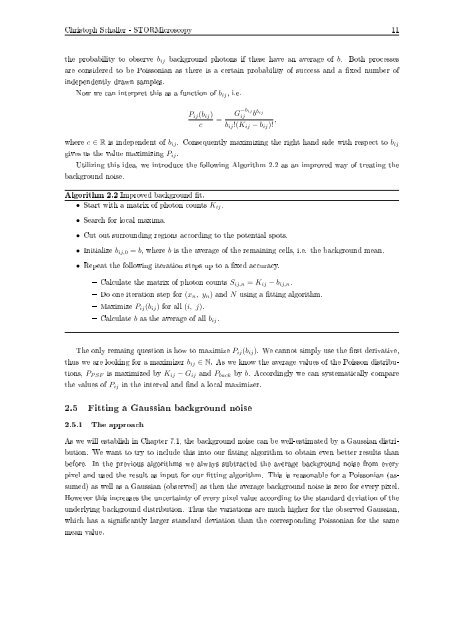Christoph Florian Schaller - FU Berlin, FB MI
Christoph Florian Schaller - FU Berlin, FB MI
Christoph Florian Schaller - FU Berlin, FB MI
Create successful ePaper yourself
Turn your PDF publications into a flip-book with our unique Google optimized e-Paper software.
<strong>Christoph</strong> <strong>Schaller</strong> - STORMicroscopy 11<br />
the probability to observe b ij background photons if these have an average of b. Both processes<br />
are considered to be Poissonian as there is a certain probability of success and a xed number of<br />
independently drawn samples.<br />
Now we can interpret this as a function of b ij , i.e.<br />
P ij (b ij )<br />
c<br />
=<br />
G −bij<br />
ij b bij<br />
b ij !(K ij − b ij )! ,<br />
where c ∈ R is independent of b ij . Consequently maximizing the right hand side with respect to b ij<br />
gives us the value maximizing P ij .<br />
Utilizing this idea, we introduce the following Algorithm 2.2 as an improved way of treating the<br />
background noise.<br />
Algorithm 2.2 Improved background t.<br />
• Start with a matrix of photon counts K ij .<br />
• Search for local maxima.<br />
• Cut out surrounding regions according to the potential spots.<br />
• Initialize b ij,0 = b, where b is the average of the remaining cells, i.e. the background mean.<br />
• Repeat the following iteration steps up to a xed accuracy.<br />
Calculate the matrix of photon counts S ij,n = K ij − b ij,n .<br />
Do one iteration step for (x n , y n ) and N using a tting algorithm.<br />
Maximize P ij (b ij ) for all (i, j).<br />
Calculate b as the average of all b ij .<br />
The only remaing question is how to maximize P ij (b ij ). We cannot simply use the rst derivative,<br />
thus we are looking for a maximizer b ij ∈ N. As we know the average values of the Poisson distributions,<br />
P P SF is maximized by K ij − G ij and P back by b. Accordingly we can systematically compare<br />
the values of P ij in the interval and nd a local maximizer.<br />
2.5 Fitting a Gaussian background noise<br />
2.5.1 The approach<br />
As we will establish in Chapter 7.1, the background noise can be well-estimated by a Gaussian distribution.<br />
We want to try to include this into our tting algorithm to obtain even better results than<br />
before. In the previous algorithms we always subtracted the average background noise from every<br />
pixel and used the result as input for our tting algorithm. This is reasonable for a Poissonian (assumed)<br />
as well as a Gaussian (observed) as then the average background noise is zero for every pixel.<br />
However this increases the uncertainty of every pixel value according to the standard deviation of the<br />
underlying background distribution. Thus the variations are much higher for the observed Gaussian,<br />
which has a signicantly larger standard deviation than the corresponding Poissonian for the same<br />
mean value.









